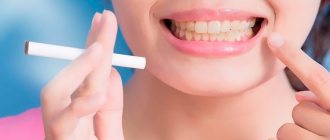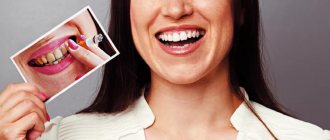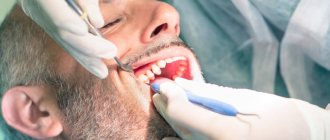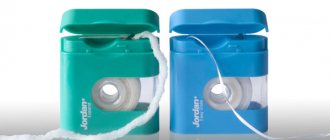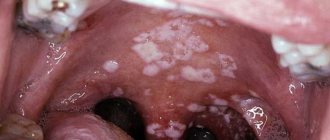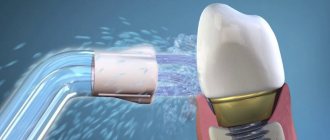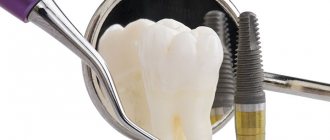Dentistry Apex-D / Memo for the patient / Recommendations after brushing your teeth
Recommendations after professional oral hygiene are a set of healing procedures for long-term preservation of the effect; subject to the recommended time interval between visits to the doctor, professional hygiene does not have any potential harmful effects on the tissues of the teeth and gums.
What can you eat after cleansing?
After the procedure, dentists impose a number of restrictions on the patient’s eating behavior. In the first 2-3 days, foods that irritate tooth enamel are excluded from the diet: sour, hot, salty, sweet. The sensitivity of teeth after ultrasonic cleaning of stone is increased: bright tastes and temperature changes provoke pain.
Products containing dyes are prohibited. The list of what not to eat after brushing your teeth for tartar includes:
- black tea and coffee;
- colored carbonated drinks;
- chocolate;
- soy and balsamic vinegar;
- mustard and curry spices;
- red wine and grapes;
- berries (blueberries, blueberries, currants);
- red and orange vegetables;
- sweets containing dyes.
A number of products are recommended for consumption. They strengthen tooth enamel and prevent the formation of plaque and caries. Dentists advise eating dairy products in any form. Fruits and vegetables, particularly apples, reduce the amount of tartar. It is useful to drink diluted apple juice, which dissolves plaque.
Smell from the mouth
This phenomenon is primarily associated with the low quality of dental services, when subgingival plaque is not completely cleaned. In addition, some of the causes of unpleasant odor include:
- neglect of recommendations for daily hygiene care;
- insufficient cleaning of dentures (removable and fixed);
- eating raw garlic and onions;
- exacerbation of periodontal inflammatory processes;
- cyst formation;
- pathologies of the salivary glands.
Symptoms often indicate the presence of inflammatory processes in the body. For example, the smell of acetone is characteristic of diabetes. You should also pay attention to the condition of the gastrointestinal tract and upper respiratory tract. Suspicion of gastritis, sinusitis or endocrinological pathology requires immediate consultation with specialized specialists.
The above recommendations should be followed after any type of professional cleaning. It is important to understand that during this period, minor discomfort and increased sensitivity of the teeth are normal. With proper care, after 5-7 days the unpleasant sensations cease to bother you, and the reward is a snow-white smile and a good mood!
Contraindications
Teeth brushing in dentistry, as a medical procedure, has a number of contraindications:
- cardiac arrhythmia;
- colds and infectious diseases;
- diabetes;
- pregnancy;
- HIV, AIDS, hepatitis;
- increased sensitivity of teeth or inflammation of gums;
- destruction of enamel;
- childhood and adolescence.
The procedure for cleaning teeth from foreign substances, according to generally accepted standards, is carried out as follows:
- After a thorough examination of the oral cavity, the dentist identifies problem areas in the oral cavity.
- Cleans tartar using a special tool - an ultrasonic scaler. Since tooth enamel is harder than tartar, under the influence of ultrasound
- the stone collapses, but the tooth remains undamaged. Injury to the gums is minimal. For maximum patient comfort, doctors can use anesthesia in the form of special gels or sprays.
- Then pigment spots from tobacco, coffee and other products with a high dye content are removed. They can only be removed using a special device - Air Flow.
- It works by using pressure to push out abrasive materials to effectively clean the surface of your teeth.
- Fluoridation. This makes the enamel harder.
- At the final stage, the surface is polished with rubber brushes using a special paste.
In total, a complete cleaning cycle can take from 20 to 60 minutes.
Additional care products
Dental floss, floss. Used to clean interdental spaces. After professional cleaning, use floss carefully so as not to injure the edges of the gums. Movements are directed from the gums to the cutting edge or to the chewing surface of the crown. Floss is used several times a day, as needed (after meals, after morning and evening brushing of teeth).
Irrigator. Using an irrigator helps to maintain the results of professional hygiene for a long time. The device cleans enamel with a thin stream of water under pressure. This type of cleaning removes soft plaque well and prevents the formation of tartar. The irrigator is used once a week or less. It is better if the frequency of such cleanings is determined by a doctor, taking into account the condition of the enamel.
Other recommendations
Professional whitening in order to prevent negative consequences requires special dental care, which is not limited only to a white diet.
Dentists advise patients to adhere to several rules in the first two weeks:
- oral hygiene should be gentle (select a brush with soft bristles, a toothpaste without abrasive particles, use rinses, refuse irrigators and dental floss);
- women should give up colored lipstick and replace it with hygienic lipstick or transparent gloss;
- pay attention to the medications they take; they should not contain dyes;
- To maintain the whitening effect, it is advisable to have your teeth professionally cleaned every six months.
If you do not follow the recommendations after dental teeth whitening, you may experience rapid darkening of the enamel. After just three weeks, the effect of the procedure may no longer be noticeable. But the consequences for dental health are much more serious, since weakened oral tissues are easily susceptible to infectious and inflammatory processes.
A white diet is one of the necessary conditions for maintaining the effect of a beautiful smile after teeth whitening. A two-week dietary restriction will allow you to enjoy the results for a long time and keep your teeth healthy.
Red wine
Red wine contains tannins and chromogens that stain teeth. And the coloring effect of polyphenols, plant pigments, only enhances the effect.
Startsmile tip:
Red wine can always be replaced with white or rose, which, by the way, the French love very much. Or use a good whitening paste after drinking from the line of proven home whitening products Blanx, Global White and.
The influence of bad habits
Changing your diet with these minor adjustments for just two weeks is easy for many people. It is much more difficult to change your habits.
Bad habits such as smoking and drinking alcohol have a negative impact on teeth. It is necessary to give up smoking completely, since a snow-white, beautiful smile and nicotine are incompatible.
With alcohol, indulgences are permissible, since it is only necessary to categorically refuse drinks containing any types of dyes. But since modern alcoholic drinks (with the exception of clear ones) mostly contain coloring substances, the list of permitted alcohol is insignificant.
Soda and juices
Juices, sodas and other intensely colored drinks can seriously ruin any Hollywood smile. Be especially wary of colored sodas, whose high acidity destroys enamel, allowing dyes to easily penetrate deep into dental tissue.
Startsmile tip:
To avoid contact of the coloring liquid with your teeth, drink drinks through a straw.
How long should you stick to the diet?
It is advisable to observe the restriction on this list for at least two weeks until the protective layer of tooth enamel is restored.
In the future, consume foods with dyes, but in small quantities. If it is not possible to completely give up products with dyes, a slight deviation from the diet is acceptable, but only from the fourth day after teeth whitening. After eating foods and the list of restrictions, you should immediately brush your teeth and use a mouthwash.
The longer you manage to follow a white diet, the longer your teeth will remain snow-white. After whitening, teeth become even more sensitive to pigments, so dentists advise not to overuse products rich in dyes to maintain the effect.
Why does a tooth hurt after a filling is installed?
Minor soreness may persist for several days or even a couple of weeks, which is explained by overheating of the tissue due to the use of boron. In some situations, for example, with deep caries or when treating front teeth, increased sensitivity can persist even for several months. But in such a situation, you should still consult a doctor for an x-ray to make sure that there is no infected tissue left under the filling and that inflammation has not affected the nerve.
If the pain intensifies, the filling darkens, black spots appear under it - all this indicates that the treatment was carried out poorly and re-inflammation has begun. This is a reason to see a doctor as soon as possible.
Why do you need a diet?
The teeth whitening procedure involves influencing the natural or acquired shade of enamel with a special device or means for “evaporating” the dark pigment.
Subsequently, the protective layer of enamel becomes thinner. It takes about 10–14 days for it to fully recover. If the still fragile tooth enamel can be affected by dyes, then there is a high probability of staining the surface of the teeth. To prevent this result, dentists have developed a special white diet that excludes a number of “colored” foods from the diet.
Before the procedure or after its completion, the dentist gives the patient the necessary recommendations about acceptable and prohibited products after teeth whitening. Neglecting the recommendations can cause not only darkening of the enamel, but also the development of caries.
If the filling interferes after treatment
Even in the doctor’s office, after installing the filling, be sure to make sure that the restored tooth is not in the way (move your jaw back and forth, sideways, carefully close your teeth). The filling should not be felt or change the bite. Don’t be shy about talking to your doctor about any discomfort—sometimes the final stage of filling treatment can take even longer than removing cavities and applying filling material.
After treatment, anesthesia wears off within 1.5-2 hours. If a conductor type was used, then after 4-6 hours. Now you are beginning to fully feel the treated tooth, you can fully close your jaws and understand how comfortable you are after filling.
If you experience slight discomfort, it feels like the tooth is a little larger and your jaws aren't closing quite tightly—this is normal. The fact is that now you have been given a new filling in accordance with the bite, that is, with the shape and position of the tooth located on the opposite side. The treated tooth became taller than before - after all, there was caries and the old filling sagged. Therefore, if there is no sharp pain and obvious rejection, be patient for a few days. If the situation normalizes and you get used to it, then there is no reason to see a doctor. If discomfort persists for 1-2 weeks, you should visit your dentist to have the filling corrected.
Prohibited Products
In the first 2-3 days after cleaning, you should not eat foods that can stain your teeth enamel an unnatural color. In particular, the following products should be completely excluded:
- red: tomatoes, berries, beets and various sauces;
- yellow: curry and mustard;
- brown and black: chocolate, soy sauce, blueberries, blackberries.
It is also recommended to exclude the consumption of sweets and ice cream. This is explained by the fact that after the procedure, the teeth and gums become extremely sensitive. Cold foods will cause significant damage to the enamel.
We keep it clean!
Both after whitening and after professional hygienic teeth cleaning with ultrasound, tooth sensitivity increases, although in the case of ultrasound cleaning, unpleasant painful sensations do not occur as often and are not as pronounced. Therefore, in order to protect yourself from possible discomfort, you need to reconsider your usual diet and temporarily exclude hot, cold, sour, salty, and sweet dishes from the menu.
In addition, for the first week after removing soft dental deposits and removing tartar, you should stop smoking and consuming any foods and drinks that have coloring properties. The list of foods that should be excluded from the diet includes berries (blackberries, blueberries, black grapes and currants), vegetables (carrots, beets, tomatoes, pumpkin, red cabbage, etc.), drinks (black tea, coffee, chocolate , cocoa, lemonades and carbonated sweet drinks), juices with the addition of natural and artificial colors.
The specialists of our dental clinic recommend that all patients, after professional teeth cleaning, be sure to adhere to the rules of thorough oral hygiene - if possible, brush your teeth after every meal or use special hygiene devices (toothpicks, floss, etc.).
How often can you have your teeth cleaned by the dentist?
It is better to visit the clinic once every six months. This is enough to prevent dental diseases and eliminate accumulated deposits.
The procedure itself does not last long, about half an hour or a little more. The doctor first assesses the condition of the oral cavity, and then gives an opinion on the possibility or impossibility of professional treatment. If necessary, filling is performed, implants, prostheses and other orthopedic structures are installed. Thus, if there is a pathological process in the mouth, it is first of all important to get rid of it, and only then begin to remove plaque and whiten the units.
Coffee
Aggressive dyes contained in coffee, especially instant coffee, easily stain teeth. And much stronger than tobacco smoke. In addition, coffee can provoke the formation of yellow plaque, as it contains heavy carbohydrates and cocoa butter, not to mention sugar.
Startsmile tip:
To reduce the coloring effect, drink coffee with milk.


